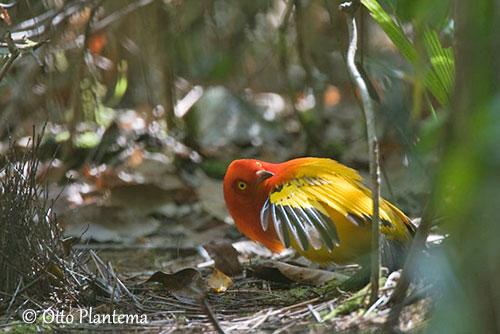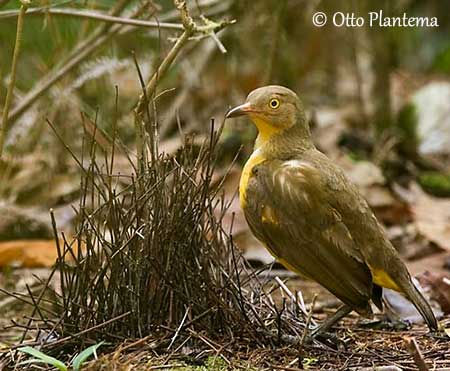
Fr: Jardinier flamboyant – Jardinier ardent
Ang: Flame Bowerbird
All: Flammenlaubenvogel
Esp: Pergolero Flamígero
Nd: Oranje Prieelvogel
Sd: flamlövsalsfågel
Photographers:
Otto Plantema
Trips around the world
Dubi Shapiro
Dubi Shapiro Photo Galleries
Text by Nicole Bouglouan
Sources:
HANDBOOK OF THE BIRDS OF THE WORLD Vol 14 by Josep del Hoyo-Andrew Elliot-David Christie - Lynx Edicions – ISBN: 9788496553507
Bowerbirds De Peter Rowland – Editeur: Csiro Publishing, 2008 – ISBN: 0643094202, 9780643094208 – 136 pages
Birds of Paradise and Bowerbirds De Phil Gregory – Editeur: Bloomsbury Publishing, 2020 – ISBN: 1472975847, 9781472975843 – 416 pages
Ottaviani, M. (2014). Les Oiseaux à berceaux - Histoire naturelle et photographies, 262 pages. Editions Prin, France. ISBN 978-2-909136-41-7
Meet The Flame Bowerbird With Colors Of Fire And An Amazing Dance Performance
What the flame bowerbird can do with its eyes is mesmerising
Meet The Flame Bowerbird – The Vibrant, Sunset-Colored, Creative Bird Engineer (10 Pics)
Flame Bowerbird: A Symbol Of The Eternal Promise Of Color
CREAGUS@Monterey Bay (Don Roberson)
Fatbirder - The World’s Richest Information Resource about Birds for Birders
Wikipedia, the free encyclopaedia

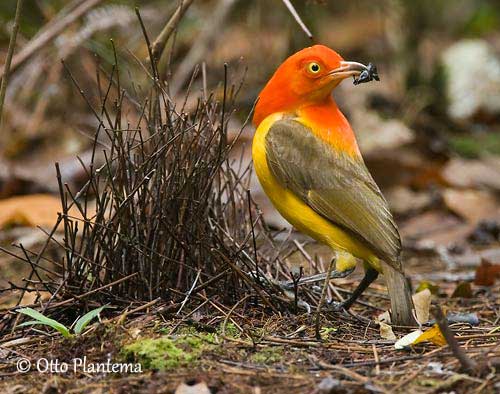
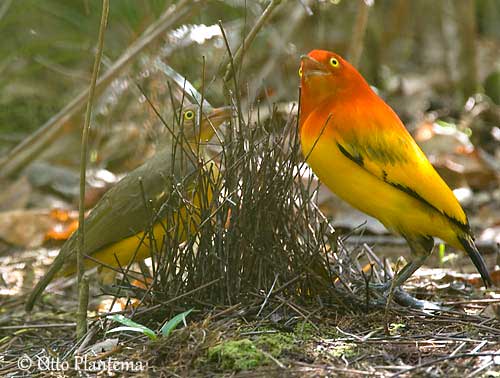
Flame Bowerbird
Sericulus ardens
Passeriformes Order – Ptilonorhynchidae Family
INTRODUCTION:
The Flame Bowerbird is endemic to the rainforests of New Guinea. The members of the genus Sericulus are known as “silky bowerbirds”, a reference to the silky appearance of their plumage. The adult plumage shows a distinctive sexual dimorphism, with very colourful males and much duller females.
The Flame Bowerbird frequents lowland and foothill rainforest, and patches in flat savanna where it feeds on fruits and insects.
The courtship behaviour is spectacular. The male displays close to the small avenue bower. It adopts elaborate postures and movements to enhance its beautiful plumage, while uttering rasping notes and reducing the black pupils, making its orange-yellow eyes much larger.
The Flame Bowerbird is affected by degradation and loss of the habitat. It is described as uncommon, but currently, the species is not globally threatened.
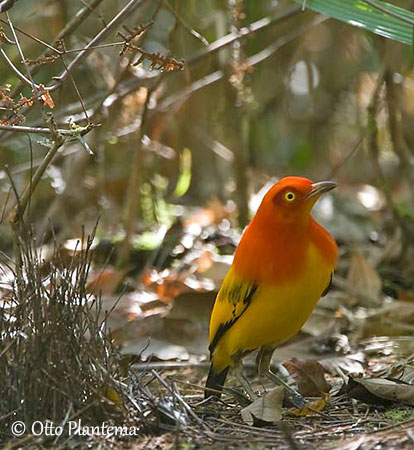
DESCRIPTION OF THE BIRD:
Biometrics:
Length: 25-26 cm
Weight: M (captive): 120-140 g – F (captive): 127-168 g
The Flame Bowerbird adult male has crown, nape and mantle bright orange-red. The wings are deep yellow with some black spots above the carpal joint, forming a black patch. The flight-feathers are black. Rump and uppertail-coverts are deep yellow. The tail is black with fine yellow edges on some rectrices, and very faint yellow tips.
The underparts are also deep yellow but paler than the upperparts. The upper breast is orange-red. Chin and upper throat are slightly paler yellow.
The head is deep orange-red.
The bill is pale grey with pale yellowish base. The eyes are bright yellow. Legs and feet are blackish.
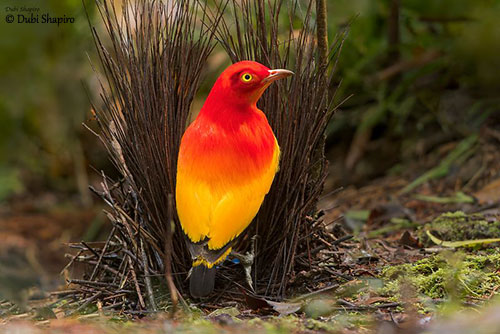
The female is much duller than male, with olive-brown upperparts with some orange wash on mantle’s feathers.
On the underparts, throat and upper breast are yellowish-olive to olive-brown. Rest of underparts is yellow. She has slightly longer tail than male.
The eyes are yellow, but paler than male.
The juvenile has silvery grey crown and bare face, bright flesh-pink bill base and throat, and downy white plumage on the underparts, with faint yellow wash becoming later like female but paler. Some yellow feathering intrudes into the white plumage on each side of the sternum. The eyes are dark grey-brown.
The immature male resembles adult female.
The subadult male is like adult female, but with few to almost all feathers of adult male plumage intruding into female-like plumage.
RANGE:
The Flame Bowerbird is found in S New Guinea in Torricelli and Prince Alexander Mountains.
HABITAT:
The Flame Bowerbird frequents lowland forests up to about 760 metres of elevation. It occurs in lowland and foothill rainforest, but also in tall secondary forest and some patches in flat savanna.
CALLS AND SONGS: SOUNDS BY XENO-CANTO
The Flame Bowerbird gives harsh, rasping and hissing notes. We can also hear an often repeated “shh” or a faint “ksh” note.
The male is polygynous, and the typical songs of polygynous Sericulus species consist of variable, far-carrying, harsh, jarring, churring, rattling sounds, but also deep and hollow whistled notes.
BEHAVIOUR IN THE WILD:
The Flame Bowerbird feeds on fruits and insects (the latter especially to feed the chicks).
The bowerbirds usually forage alone or in pairs, but also in small groups or even true flocks.
The birds often forage in tree canopy and subcanopy, searching for food on foliage, branches, epiphytes and tree trunks. But they also probably forage on the ground, especially in the leaf litter.
The fruits are taken while perching upright or leaning forwards or sideways, in order to pluck and swallow the fruit whole.
Insects are mainly caught during both courtship and nesting periods.
The courtship displays of the bowerbirds are spectacular.
The Flame Bowerbird is conspicuous on the forest floor with its brightly-coloured plumage.
The male builds an “avenue-bower”. It builds first a small, neat avenue, usually with few decorations. But we can find some items such as blue, purple and brown fruits, purple and white flowers, fungi, snail shells, and yellow-brown leaves within the avenue. The outer part is lined with glossy blackish leaves.
The walls of the avenue are usually made of thick, short sticks in the outer bases of the wall, whereas finer, longer sticks are used in the inner bases.
The avenue is about 17 cm long and 8 cm wide. The bower itself is about 23 cm long, 16 cm wide and 19 cm high on the outer part.
The male maintains this elaborate structure to attract the females.
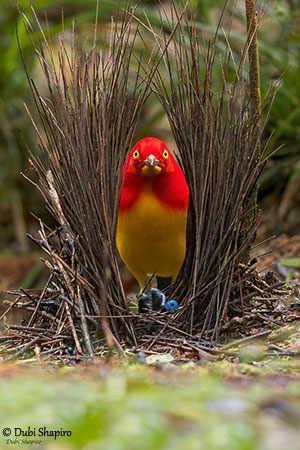
The courtship displays are complex. The male turns and coils its tail and wings to its sides while moving the head rapidly, indulging in a dance ritual to attract a female.
When a female approaches to visit the bower, the male may collect some sticks with the bill and begins its dance. It tries to appear as small as possible, before puffing up the plumage to look bigger. The effect is reinforced when the male extends its wings.
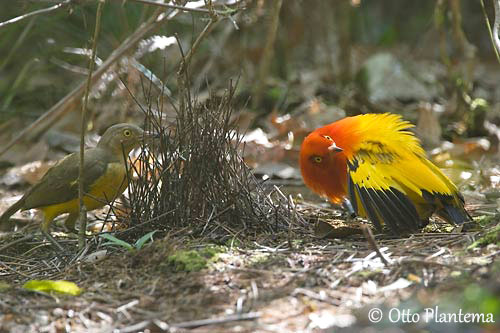
It is time for the female to inspect the bower. The male intensifies the dance and continues to extend its wings. But it is also able to “play” with its eyes, with the deep yellow irises and the black pupils alternating to change the eye’s colour. The irises can be entirely yellow with only a very small black pupil, and in addition, not necessarily both eyes but only one, making the gaze hypnotic.
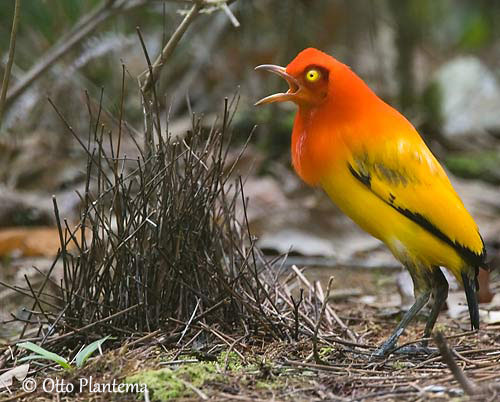
When both mates are at the bower, they touch their bills.
During the displays, the male produces some rasping and hissing notes. Some items such as insect or berries can be seen in the bill.
Following displays and copulation, the female builds a separate “true” nest where she will lay her eggs. The nest is a saucer-shaped structure placed high above the ground. She lays and protects her eggs without help from the male which is polygynous and tries to attract other females.
The Flame Bowerbird is probably resident.
The flight is strong and purposeful, and becomes conspicuously undulating while the bird is flying over large open areas.
The wings may produce an audible rustling sound in normal flight. The males which have a bower perform a fast and always direct flight to the fruiting trees.
REPRODUCTION OF THIS SPECIES:
The displays take place in May-July in E of the range, and between August and November near Strickland R.
The male is polygynous. Following bower building, courtship displays and copulation, the female builds a true nest to lay her eggs, while the male tries to attract other females.
The female builds a saucer-shaped structure with leaves and plant tendrils in tree fork, bush or vine tangles. It is placed high above the ground. The nest-site is usually cryptic and isolated from the surrounding vegetation.
She lays a single egg in captivity, but probably 2-3 in the wild. She incubates alone during 19-24 days. The chicks leave the nest about three weeks after hatching. They are fed and protected by the female, without help from the male. They become independent 50-56 days after hatching.
No more information on nesting period in the wild.
PROTECTION / THREATS / STATUS:
The Flame Bowerbird is threatened by degradation and loss of the habitat, caused by deforestation.
The main predators of the species are the Birds of Prey.
The species is described as generally uncommon, but the population is not globally threatened.
The Flame Bowerbird is currently evaluated as Least Concern.
